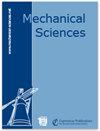Structural optimization of a pipe-climbing robot based on ANSYS
IF 1.5
4区 工程技术
Q4 ENGINEERING, MECHANICAL
引用次数: 0
Abstract
Abstract. In order to improve the structural performance of the out-of-pipe pipe-climbing robot, the out-of-pipe pipe-climbing robot is optimized. First, MATLAB software was used to optimize the structure and size of the robot according to the mathematical model of robot mechanics and size constraints. Then, SolidWorks software was used to establish a three-dimensional model of the robot which was then imported into ANSYS Workbench software. Static and modal analyses were then performed on key robot components under different working conditions and the topology optimization module in ANSYS Workbench was used to perform the topology optimization of the key components. Finally, the optimized components were statically analysed. By comparing the performance of the components before and after optimization, it was found the weights of the optimized frame and clamping arm were respectively reduced by 24 % and 20 %, and the maximum stress was respectively reduced by 46 % and 20 %. Ultimately, it was found that the stiffness and strength of the robot were improved and a lighter weight was achieved via optimization; thus, this work provides a reference for future research on pipe-climbing robots.基于ANSYS的爬管机器人结构优化
摘要为了提高无管爬管机器人的结构性能,对管外爬管机器人进行了等距设计。首先,根据机器人力学的数学模型和尺寸约束,利用MATLAB软件对机器人的结构和尺寸进行了优化。然后,利用SolidWorks软件建立了机器人的三维模型,并将其导入ANSYSWorkbench软件中。然后对不同工况下的关键机器人部件进行了静态和模态分析,并使用ANSYS Workbench中的拓扑优化模块对关键部件进行了拓扑优化。最后,对优化后的组件进行了静态分析。通过比较优化前后各部件的性能,发现优化后的车架和夹紧臂的重量分别减少了24 % 和20 %, 最大应力分别降低了46 % 和20 %. 最终,通过优化,提高了机器人的刚度和强度,实现了更轻的定位;因此,本工作为今后管道攀爬机器人的研究提供了参考。
本文章由计算机程序翻译,如有差异,请以英文原文为准。
求助全文
约1分钟内获得全文
求助全文
来源期刊

Mechanical Sciences
ENGINEERING, MECHANICAL-
CiteScore
2.20
自引率
7.10%
发文量
74
审稿时长
29 weeks
期刊介绍:
The journal Mechanical Sciences (MS) is an international forum for the dissemination of original contributions in the field of theoretical and applied mechanics. Its main ambition is to provide a platform for young researchers to build up a portfolio of high-quality peer-reviewed journal articles. To this end we employ an open-access publication model with moderate page charges, aiming for fast publication and great citation opportunities. A large board of reputable editors makes this possible. The journal will also publish special issues dealing with the current state of the art and future research directions in mechanical sciences. While in-depth research articles are preferred, review articles and short communications will also be considered. We intend and believe to provide a means of publication which complements established journals in the field.
 求助内容:
求助内容: 应助结果提醒方式:
应助结果提醒方式:


